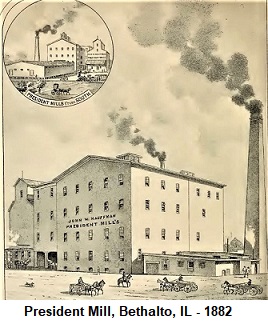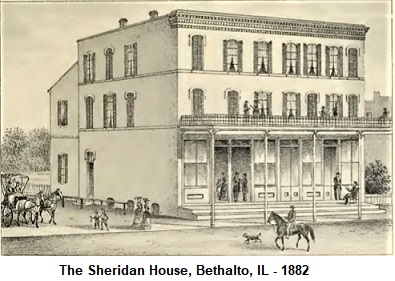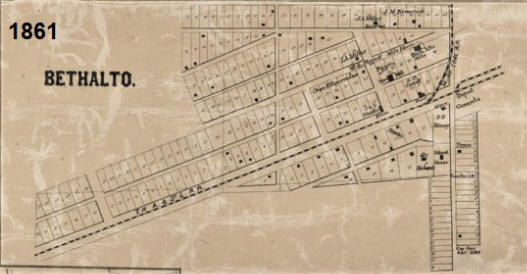Early History of Bethalto (Rattan Prairie)
Rattan’s Prairie is located in the northeastern section of Wood
River Township, where the future Bethalto would be established. It
was given its name from the fact that Thomas Rattan settled on
Section 13 in the township in 1804. He came to Illinois from Ohio,
and was the first white man to settled near the Wood River. He was a
member of the first grand jury convened in Madison County in 1819.
Thomas raised a large family, and sometime after the War of 1812, he
moved to Greene County. Robert Collet, an ingenious and enterprising
man, settled on Rattan’s Prairie and built a mill, two or three
miles southeast of the present town of Bethalto. It was destroyed by
fire in 1842 or 1843.
Bethalto was laid out by Joel Underwood Starkey, an early settler of
Rattan Prairie. The plat was recorded June 23, 1854. Part of the
town is in Wood River Township, with the eastern part in Fort
Russell Township. The town was first named Bethel, but when the post
office was established, it was discovered another town of the same
name already existed in Illinois, and the name was changed to
Bethalto (a combination of Bethel and Alton). Joel was born April
18, 1822, and was the son of Jesse Starkey, a Justice of the Peace
in Madison County from 1827 – 1843. Joel later moved to Lincoln,
Logan County, Illinois.
In 1814, Jesse Starkey and his son had gone out to find their
horses, which had wandered off some distance from the cabin. As was
the custom then, each bore a rifle and wore buckskin clothing. It
was a foggy morning, and they had separated to make a more thorough
search. Starkey and his son had unknowingly strayed near each other,
with nothing but a thicket of brush separating them. They saw what
they thought was an Indian, but were actually seeing each other. The
father was the first to shoot. Fortunately, the wound was not
mortal, and the boy recovered.
It was recorded that Molley, an African-American woman, aged 45,
bound herself to Joel Starkey for 40 years, beginning January 2,
1818.
Jesse Starkey died in July 1874. He had lived nearly three-fourths
of a century in Bethalto, and was highly respected by all. Joel
Starkey died May 4, 1892, in El Dorado Springs, Cedar County,
Missouri. He was buried in Zion Cemetery in Lincoln, Illinois.
The first building in Bethalto was a board shanty, sixteen feet
square, on Oak Street, erected by Thomas Smith in 1854. Mr. Smith
used it as a dwelling, and also kept a small stock of groceries. The
next business house was built by William Tyron in the spring of
1855. It was a frame building, 30x40, and was on Prairie Street. Mr.
Tyron had a general stock of goods, and continued his business for
some years. The next industry in Bethalto was a brick yard,
established by John A. Miller in the spring of 1856, located north
of the railroad on the corner of Mill and Oak Streets. That same
spring, the firm of Hamilton & Piggett erected a steam circular saw
mill on the north side of the railroad on Oak Street, between Second
and Third. At that time, Bethalto and the nearby countryside was
covered with heavy timber, and the mill flourished and did a
thriving business. After a few years timber became scarce, and the
mill was moved to Hamel Township.
William Tyron kept the first post office in 1855. The first hotel
was built and kept by Anthony B. Carroll in 1858. This hotel was
located on Prairie Street, north of the railroad. The first
blacksmiths were the firm of Richard & Samuels, which was
established in 1856, and was located on Second and Oak Streets,
north of the railroad. The first church was erected by the
Catholics, and dedicated in the summer of 1862. It was a frame
structure. The first Justice of the Peace of Bethalto was John A.
Miller.
Bethalto was incorporated as a town under a special act in force, on
April 19, 1869. The first officers were: Jacob Huppert, President of
the board; trustees John P. Richards, J. P. Cumming, J. C. Baugert,
and John Jackson. On April 23, 1873, an election was held to
determine whether the town should incorporate as a village under
general law. The result was in favor of organization, and on May 5,
1873, an election was held to choose village officers. The following
were elected: Stephen A. Albro, President of the Board; Trustees
Conrad H. Flick, John V. Richards, Adam Elspermann, Charles Gundall,
and John Stolze; Clerk William E. Lehr; Police Magistrate John A.
Miller. Frank M. Randle was appointed Village Constable, F. W.
Stolze, Superintendent of Streets, and Lewis Kleim, treasurer.
 In 1859, the President Merchant Mills and Elevator was established
by James Neimrick. It had the capacity of manufacturing 100 barrels
of flour daily. In 1877, it was torn down and rebuilt by new owners
Meyer & Guye, with a daily capacity of 500 barrels. In 1879, Meyer
and Guye both died, and in the following year the mill was leased by
E. O. Standard & Co. In January 1881, the mill was purchased by J.
W. Kauffman, who increased its capacity to 600 barrels. In 1882, a
complete change was made in the grinding apparatus, which was
considered far in advance of the old system. The mill was 54x80,
five stories high, and had a stone basement. The elevator, in
connection with the mill, was 40x80 feet, and 85 feet high. It had
the capacity of elevating 15,000 bushels of grain daily, and of
storing 70,000 bushels of wheat. A warehouse, 65x150 feet, was
nearby, which stored 10,000 barrels of flour. The mill also had a
cooper shop, and was located on Mill Street. The President Mills was
destroyed by fire in 1882, but was rebuilt. It was destroyed by fire
a final time in 1895.
In 1859, the President Merchant Mills and Elevator was established
by James Neimrick. It had the capacity of manufacturing 100 barrels
of flour daily. In 1877, it was torn down and rebuilt by new owners
Meyer & Guye, with a daily capacity of 500 barrels. In 1879, Meyer
and Guye both died, and in the following year the mill was leased by
E. O. Standard & Co. In January 1881, the mill was purchased by J.
W. Kauffman, who increased its capacity to 600 barrels. In 1882, a
complete change was made in the grinding apparatus, which was
considered far in advance of the old system. The mill was 54x80,
five stories high, and had a stone basement. The elevator, in
connection with the mill, was 40x80 feet, and 85 feet high. It had
the capacity of elevating 15,000 bushels of grain daily, and of
storing 70,000 bushels of wheat. A warehouse, 65x150 feet, was
nearby, which stored 10,000 barrels of flour. The mill also had a
cooper shop, and was located on Mill Street. The President Mills was
destroyed by fire in 1882, but was rebuilt. It was destroyed by fire
a final time in 1895.
Another mill – the Karnack Mill – was established by Ewan Flick in
the fall of 1872, and passed into the hands of the senior member of
the firm, J. T. Ewan, in the fall of 1879. It was located on Prairie
Street. It was a frame building, two stories high, with a basement.
It had an engine room of 16x40 feet. The mill had the capacity of
grinding 100 barrels of flour daily.
There were two small coal mines near the suburbs of Bethalto. One
was owned by David Brunton, and the other by Michael Mayer. Bethalto
was situated over a fine vein of coal, from five to eight feet in
thickness, and was obtained by going only about 70 feet below the
surface.
The Sheridan House hotel was built in 1882 by Conrad H. Flick. It
was a fine
The public hall was located in the second story of the Neisler
building. It had a stage, and seated approximately 500 people.
A Cornet Band was organized in about 1880, with thirteen members,
all uniformed. At their founding, the band had eleven horns, two
tenor drums, and one bass drum.
The Bethalto school house was a brick building in the eastern part
of the village, and was constructed in 1867 at a cost of $7,000. It
was two stories high, with a cupola and bell, and contained four
rooms. Four teachers were employed.
There were three churches by 1882 – the Cumberland Presbyterian,
United Baptist, and Catholic.
In 1882, there were the following businesses:
Groceries, Queensware, Etc. – John Hickerson.
Druggists and Pharmacists – Neisler & Randall.
Boot and Shoe Store – Charles C. Bangert.
Hardware, Tinware, & Agricultural Implements – Neisler & Randall.
Hardware, Groceries & Agricultural Implements – John A. Miller.
Furniture and Undertaking – George Dorr.
Tin Ware – Isaac Scammill.
Watch Maker and Jeweler – August Smitz.
Harness and Saddlery – John Gray.
Physicians – N. B. Richards, E. W. Reed, Joseph Cobb.
Blacksmithing – John Bahr, Gottleib Klem.
Wagon Maker – Charles Buck.
Painters – Charles Andrews, Mr. Angil.
Barbers – August Smitz, John Russell.
Restaurants – Mary McAliney, Hannah Gill.
Livery Stable – Joseph Starkey.
Justices – John A. Miller, C. H. Flick.
Notaries, Insurance & Real Estate – W. L. Piggett, John A. Miller.
Carpenter and Builder – C. H. Flick.
Shoe Makers – Charles Langhart, Charles Bangert & Charles Gundall.
Meat Market – John Falkenburg.
Milliners and Dress Makers – Laura Smith, Mrs. Cobb.
Carpet Weaver – Caroline Starkey.
Postmaster – W. H. Battles.
There were five saloons in 1882.
